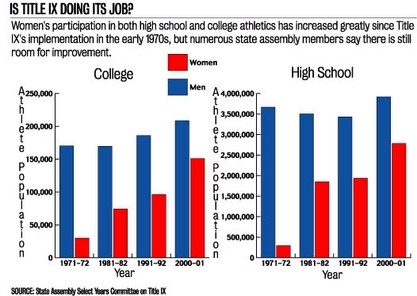Facts from ACLU
- In 2001,
- 41.5% of high school athletes in the U.S. were women, compared to 7.4 percent in 1972.
- 43% of college varsity athletes were women – an increase of more than 403% compared to 1971.
- 69% of junior high students, compared with 26% in 1993, said that their schools have a policy to deal with sexual harassment and complaints.
- In 2003-04,
- Women earned 57% of all bachelor's degrees,
- Women earned 59% of all master's degrees, compared to 49% in 1979-80.
- Women earned 47% of all doctoral level degrees, compared to 30% in 1979-80.
- In 2006,
- 2.95 million women athletes played competitive sports, compared to fewer than 300,000 in 1972.
- In 2007,
- The number of women participating in college athletics exceeds 166,000, compared to just 32,000 in 1972.
We Still Have a Long Way To Go…
- In 2000,
- 36% of eighth grade boys compared to 27% of eighth grade girls performed at or above a level deemed proficient in science and math.
- 21% of twelfth grade boys compared to 16% of twelfth grade girls performed at or above a level deemed proficient in science and math.
- In 2001, 83% of girls and 79% of boys attending public junior high schools experienced some form of sexual harassment.
- In 2002,
- Women received only 20% of computer science and engineering-related technology bachelor's degrees.
- For every new dollar going into college athletics at the Division I and II levels, male sports received 65 cents while female sports received 35 cents.
- Only 21% of full professors at colleges and universities were women.
- Phone surveys by the National Women's Law Center found that about half of the states have no employee designated to coordinate efforts to comply with Title IX, despite legal requirements that an employee fill this role.
- In 2003, male athletes enjoyed 1.1 million more high school athletic participation opportunities than female athletes, 57,000 more college opportunities (out of a total of 400,000) and $133 million more in athletic scholarship assistance.
- In 2007, female participation in intercollegiate sports remains below pre-Title IX male participation:
- While 170,384 men played college sports in 1971, only about 166,000 women play college sports today.
- While 53% of the students at Division I schools are women, female athletes in Division I receive just 32% of the funds to recruit new athletes, 37% of total athletics expenditures, 45% of total athletic scholarships, and 44% of the opportunities to play intercollegiate sports.
“The triumph can’t be had without the struggle. And I know what struggle is. I have spent a lifetime trying to share what it has meant to be a woman first in the world of sports so that other young women have a chance to reach their dreams.” — Wilma Rudolph, Olympic gold medalist

